目录原理实现思路主要代码原理 我们通过相机拍摄的图片存在各种畸变,其中投影畸变使得原本平行的直线不再平行,就会产生照片中近大远小的效果,要校正这一畸变,书中给了很多方法,这里是其中的
我们通过相机拍摄的图片存在各种畸变,其中投影畸变使得原本平行的直线不再平行,就会产生照片中近大远小的效果,要校正这一畸变,书中给了很多方法,这里是其中的一种。
我们可以将投影变换拆分成相似变换、仿射变换和投影变换三部分, 如下图,

其中相似变换和仿射变换不会改变infinite line,只有投影变换会改变。因此只要找到畸变图像中的这条线,就能够恢复图像的仿射特性(相当于逆转投影变换)。而要确定这条线的位置,就得至少知道线上的两个点。我们知道,所有平行线的交点都在infinite line上面,因此,我们只需要找到图像上的两对平行线(原本是平行,图像上不再平行),求出对应的两个交点,就能找到infinite line了,如下图
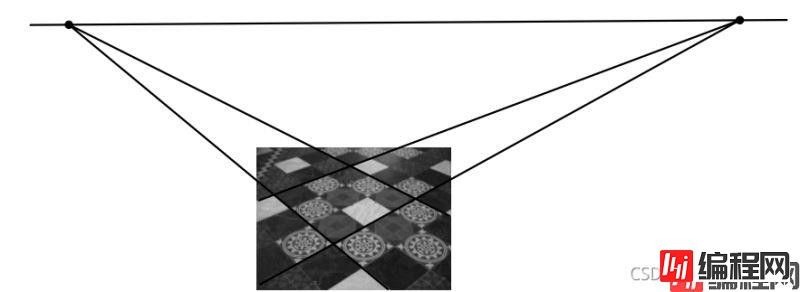
进而可以图像的恢复仿射特性。
首先我们的畸变图像如下图,
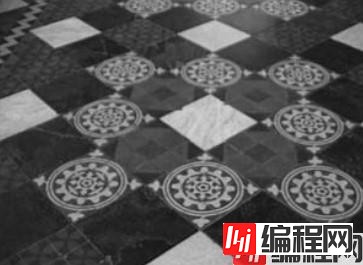
利用公式:
l = x1 × x2
可以通过x1、x2的齐次坐标求出两点连线l的齐次坐标。在图中我们找到两对平行线l1、l2和l3、l4,如下图
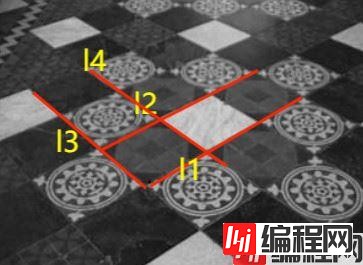
利用公式:
x = l1 × l2可以通过l1、l2以及l3、l4的齐次坐标分别求出两对平行线的交点A12、A34,直线A12A34就是我们要找的infinite line。假设该直线的齐次坐标为(l1,l2,l3),那么通过矩阵:
H = ((1,0,0),(0,1,0),(l1,l2,l3))
就能够将直线(l1,l2,l3)变换成(0,0,1),即将该直线还原成为infinite line。同理我们也可以利用H矩阵,通过公式:
x = Hx'
还原投影畸变。
代码一共需要运行两次
第一次运行的主函数:
int main()
{
Mat src = imread("distortion.jpg", IMREAD_GRAYSCALE);
IplImage *src1 = cvLoadImage("distortion.jpg");
//第一步,通过鼠标获取图片中某个点的坐标,运行第一步时注释掉Rectify(points_3D, src, src1);,将获取到的八个点写入
//points_3d[8]坐标数组中,因为是齐次坐标,x3 = 1
GetMouse(src1);
//输入畸变图上的8个关键点
Point3d points_3d[8] = { Point3d(99, 147, 1), Point3d(210, 93, 1), Point3d(144, 184, 1), Point3d(261, 122, 1),
Point3d(144, 184, 1), Point3d(99, 147, 1), Point3d(261, 122, 1), Point3d(210, 93, 1) };
//第二步,校正图像,运行此步骤时注释掉GetMouse(src1);,解除注释Rectify(points_3d, src, src1);
//Rectify(points_3d, src, src1);
imshow("yuantu", src);
waiTKEy(0);
}
其他函数:
void on_mouse(int event, int x, int y, int flags, void* ustc)
{
CvFont font;
cvInitFont(&font, CV_FONT_HERSHEY_SIMPLEX, 0.5, 0.5, 0, 1, CV_AA);
if (event == CV_EVENT_LBUTTONDOWN)
{
CvPoint pt = cvPoint(x, y);
char temp[16];
sprintf(temp, "(%d,%d)", pt.x, pt.y);
cvPutText(src, temp, pt, &font, cvScalar(255, 255, 255, 0));
cvCircle(src, pt, 2, cvScalar(255, 0, 0, 0), CV_FILLED, CV_AA, 0);
cvShowImage("src", src);
}
}
void GetMouse(IplImage *img)
{
src = img;
cvNamedWindow("src", 1);
cvSetMouseCallback("src", on_mouse, 0);
cvShowImage("src", src);
waitKey(0);
}
在弹出来的图片中点击任意地方可获得改点的图像坐标(x1,x2),如下图:
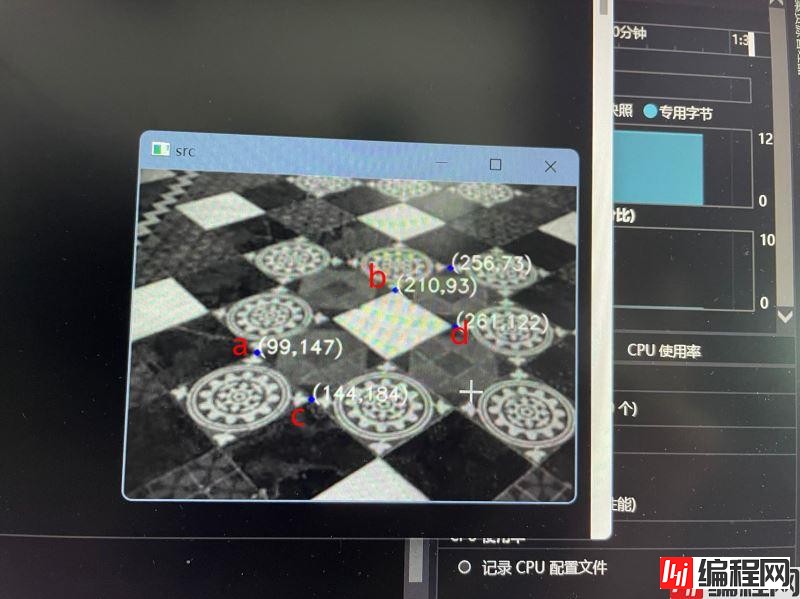
我选取了a、b、c、d四个点,其中:
ab // cd ac // bd
将这四个点的坐标按照a、b、c、d、c、a、d、b的顺序填入points_3d[8]坐标数组中,第一次运行结束。
第二次运行的主函数:
int main()
{
Mat src = imread("distortion.jpg", IMREAD_GRAYSCALE);
IplImage *src1 = cvLoadImage("distortion.jpg");
//第一步,通过鼠标获取图片中某个点的坐标,运行第一步时注释掉Rectify(points_3d, src, src1);,将获取到的八个点写入
//points_3d[8]矩阵中,因为是齐次坐标,x3 = 1
//GetMouse(src1);
//输入畸变图上的8个关键点
Point3d points_3d[8] = { Point3d(99, 147, 1), Point3d(210, 93, 1), Point3d(144, 184, 1), Point3d(261, 122, 1),
Point3d(144, 184, 1), Point3d(99, 147, 1), Point3d(261, 122, 1), Point3d(210, 93, 1) };
//第二步,校正图像,运行此步骤时注释掉GetMouse(src1);,解除注释Rectify(points_3d, src, src1);
Rectify(points_3d, src, src1);
imshow("yuantu", src);
waitKey(0);
}
校正函数:
void Rectify(Point3d* points, Mat src, IplImage* img)
{
//通过输入的8个点得到4条连线
vector<vector<float>> lines;
int num_lines = 4;
for(int i = 0; i < num_lines; i++)
{
//获取两点连线
GetLineFromPoints(points[2 * i], points[2 * i + 1], lines);
}
//分别求取两个交点
vector<Point3f> intersect_points;
int num_intersect_points = 2;
for (int i = 0; i < num_intersect_points; i++)
{
//计算交点
GetIntersectPoint(lines[2 * i], lines[2 * i + 1], intersect_points);
}
//通过两个交点连线求消失线
vector<vector<float>> vanishing_line;
GetLineFromPoints(intersect_points[0], intersect_points[1], vanishing_line);
//恢复矩阵
float H[3][3] = {{1, 0, 0},
{0, 1, 0},
{vanishing_line[0][0], vanishing_line[0][1], vanishing_line[0][2]}};
Mat image = Mat::zeros(src.rows, src.cols, CV_8UC1);
GetRectifingImage(vanishing_line[0], src, image);
int i = 0;
}
void GetLineFromPoints(Point3d point1, Point3d point2, vector<vector<float>> &lines)
{
vector<float> line;
//定义直线的三个齐次坐标
float l1 = 0;
float l2 = 0;
float l3 = 0;
l1 = (point1.y * point2.z - point1.z * point2.y);
l2 = (point1.z * point2.x - point1.x * point2.z);
l3 = (point1.x * point2.y - point1.y * point2.x);
//归一化
l1 = l1 / l3;
l2 = l2 / l3;
l3 = 1;
line.push_back(l1);
line.push_back(l2);
line.push_back(l3);
lines.push_back(line);
}
void GetIntersectPoint(vector<float> line1, vector<float> line2, vector<Point3f> &intersect_points)
{
Point3f intersect_point;
//定义交点的三个齐次坐标
float x1 = 0;
float x2 = 0;
float x3 = 0;
x1 = (line1[1] * line2[2] - line1[2] * line2[1]);
x2 = (line1[2] * line2[0] - line1[0] * line2[2]);
x3 = (line1[0] * line2[1] - line1[1] * line2[0]);
//归一化
x1 = x1 / x3;
x2 = x2 / x3;
x3 = 1;
intersect_point.x = x1;
intersect_point.y = x2;
intersect_point.z = x3;
intersect_points.push_back(intersect_point);
}
int Round(float x)
{
return (x > 0.0) ? floor(x + 0.5) : ceil(x - 0.5);
}
void GetRectifingImage(vector<float> line, Mat src, Mat dst)
{
Size size_src = src.size();
for (int i = 0; i < size_src.height; i++)
{
for (int j = 0; j < size_src.width; j++)
{
float x3 = line[0] * j + line[1] * i + line[2] * 1;
int x1 = Round(j / x3);
int x2 = Round(i / x3);
if (x1 < size_src.width && x1 >= 0 && x2 < size_src.height && x2 >= 0)
{
dst.at<uint8_t>(x2, x1) = src.at<uint8_t>(i, j);
}
}
}
imshow("src", src);
imshow("dst", dst);
waitKey(0);
}
运行结果如下图:
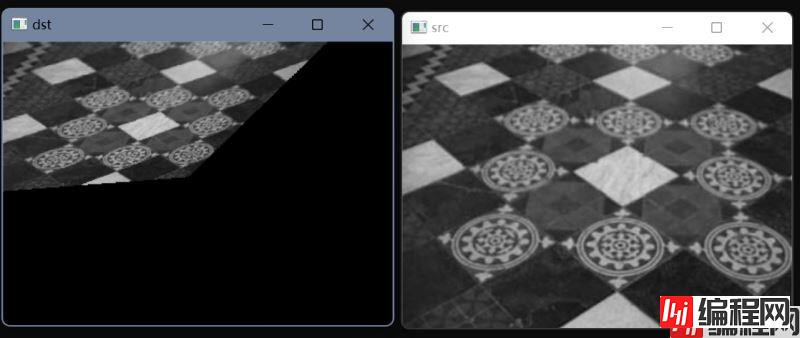
校正效果和点的选取有关,因为鼠标点击的那个点不一定是我们真正想要的点,建议一条直线的的两个点间距尽量大一些。
完整代码链接 提取码:qltt
到此这篇关于利用c++ OpenCV 实现从投影图像恢复仿射特性的文章就介绍到这了,更多相关C++ OpenCV 投影图像恢复仿射特性内容请搜索编程网以前的文章或继续浏览下面的相关文章希望大家以后多多支持编程网!
--结束END--
本文标题: 利用C++ OpenCV 实现从投影图像恢复仿射特性
本文链接: https://lsjlt.com/news/158703.html(转载时请注明来源链接)
有问题或投稿请发送至: 邮箱/279061341@qq.com QQ/279061341
2024-03-01
2024-03-01
2024-02-29
2024-02-29
2024-02-29
2024-02-29
2024-02-29
2024-02-29
2024-02-29
2024-02-29
回答
回答
回答
回答
回答
回答
回答
回答
回答
回答
0